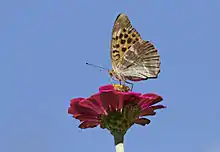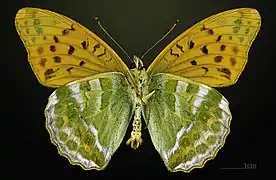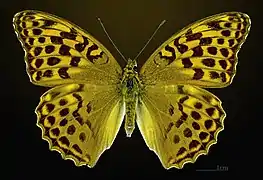Silver-washed fritillary
The silver-washed fritillary (Argynnis paphia) is a common and variable butterfly found over much of the Palearctic realm – Algeria, Europe, temperate Asia, and Japan.
| Silver-washed fritillary | |
|---|---|
_male.jpg.webp) | |
| Male New Forest, Hampshire | |
 | |
| Female Lill-Jansskogen, Stockholm | |
| Scientific classification | |
| Kingdom: | Animalia |
| Phylum: | Arthropoda |
| Class: | Insecta |
| Order: | Lepidoptera |
| Family: | Nymphalidae |
| Genus: | Argynnis |
| Species: | A. paphia |
| Binomial name | |
| Argynnis paphia | |
Description
The silver-washed fritillary butterfly is deep orange with black spots on the upperside of its wings, and has a wingspan of 54–70 mm, with the male being smaller and paler than the female. The underside is green, and, unlike other fritillaries, has silver streaks instead of silver spots, hence the name silver-washed. The caterpillar is black brown with two yellow lines along its back and long reddish-brown spines.
The male possesses scent scales on the upperside of the forewing that run along veins one to four. The scent produced from these scales attracts females and helps to distinguish it from other species.
 Male
Male Male underside
Male underside Female
Female Female underside
Female underside
Food resources
Adults feed on the nectar of bramble, thistles, and knapweeds, and also on aphid honeydew. The silver-washed is a strong flier, and more mobile than other fritillaries, and, as such, can be seen gliding above the tree canopy at high speed. Its preferred habitat is thin, sunny, deciduous woodland, especially oaks, but it has been known to live in coniferous woodland.
The main larval food plant of the species is the common dog violet (Viola riviniana).[1]
Life cycle
Unusually for a butterfly, the female does not lay her eggs on the leaves or stem of the caterpillar's food source (in this case violets), but instead one or two meters above the woodland floor in the crevices of tree bark close to clumps of violets.
When the egg hatches in August, the caterpillar immediately goes into hibernation until spring. Upon awakening, it will drop to the ground, and feeds on violets close to the base of the tree. The caterpillar usually feeds at night, and usually conceals itself during the day away from its food source, but during cool weather will bask in the sunny spots on the forest floor on dry, dead leaves. It will pupate amongst the ground vegetation, and the adults will emerge in June.
Subspecies
- A. p. butleri Krulikovsky, 1909 northern Europe, central Europe
- A. p. thalassata Fruhstorfer, 1909 southern Europe
- A. p. dives (Oberthür, 1908) Algeria
- A. p. argyrorrhytes Seitz, [1909] North Caucasus
- A. p. delila Röber, 1896 Turkey
- A. p. masandarensis Gross & Ebert, 1975 Iran
- A. p. pusilla Wnukowsky, 1927 north-west Siberia
- A. p. neopaphia Fruhstorfer, 1907 Amur
- A. p. virescens Nakahara, 1926 Kuriles
- A. p. geisha Hemming, 1934 Japan
- A. p. tsushimana Fruhstorfer, 1906 Japan
- A. p. megalegoria Fruhstorfer, 1907 Szechuan, Yunnan
- A. p. argyrophontes Oberthür, 1923 south-west China
- A. p. formosicola Matsumura
Conservation
The silver-washed fritillary was in decline in the UK for much of the 1970s and 1980s, but seems to be coming back to many of its old territories.
 Female
Female_male_3.jpg.webp) Male
Male_male_underside_2.jpg.webp) Male underside
Male underside_female_underside_2.jpg.webp) Female underside
Female underside Male
Male_mating.jpg.webp) Mating
Mating_female_Valesina.jpg.webp) Female, form valesina
Female, form valesina
References
- Source
- Tom Tolman and Richard Lewington, 2009 Collins Butterfly Guide:The Most Complete Field Guide to the Butterflies of Britain and Europe Harper Collins. ISBN 978-0-00-727977-7.
- Crory, Andrew. 2016. Fritillary Butterflies. The Irish Hare. Ulster Wildlife Membership Magazine. Issue 113 p. 4
- Notes
- "Silver-washed Fritillary". UK Butterflies. Retrieved 20 June 2011.
| Wikimedia Commons has media related to Argynnis paphia. |